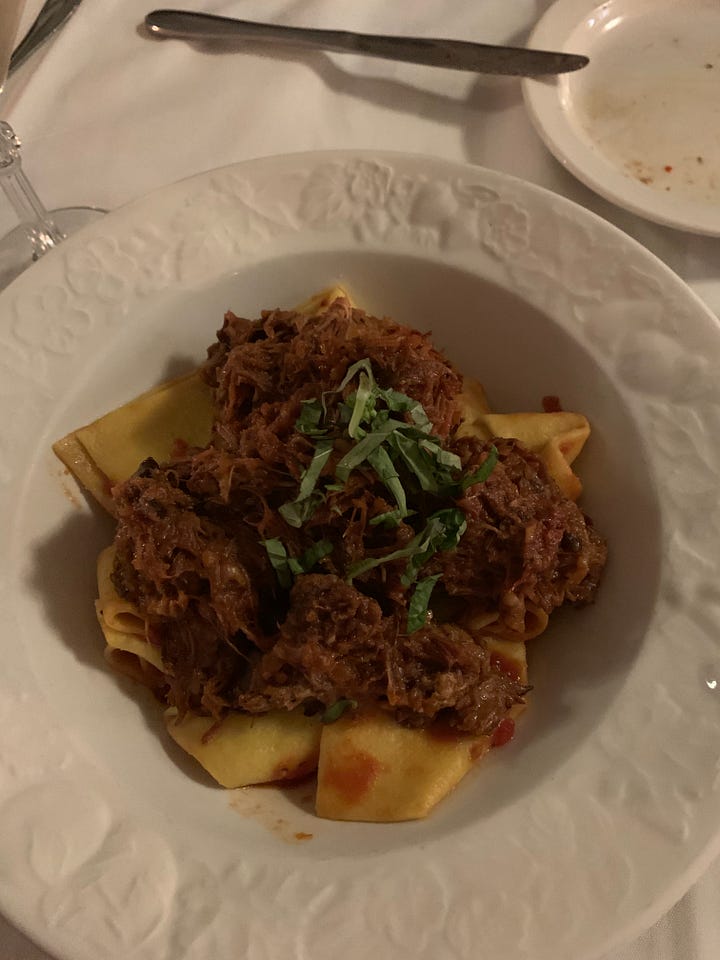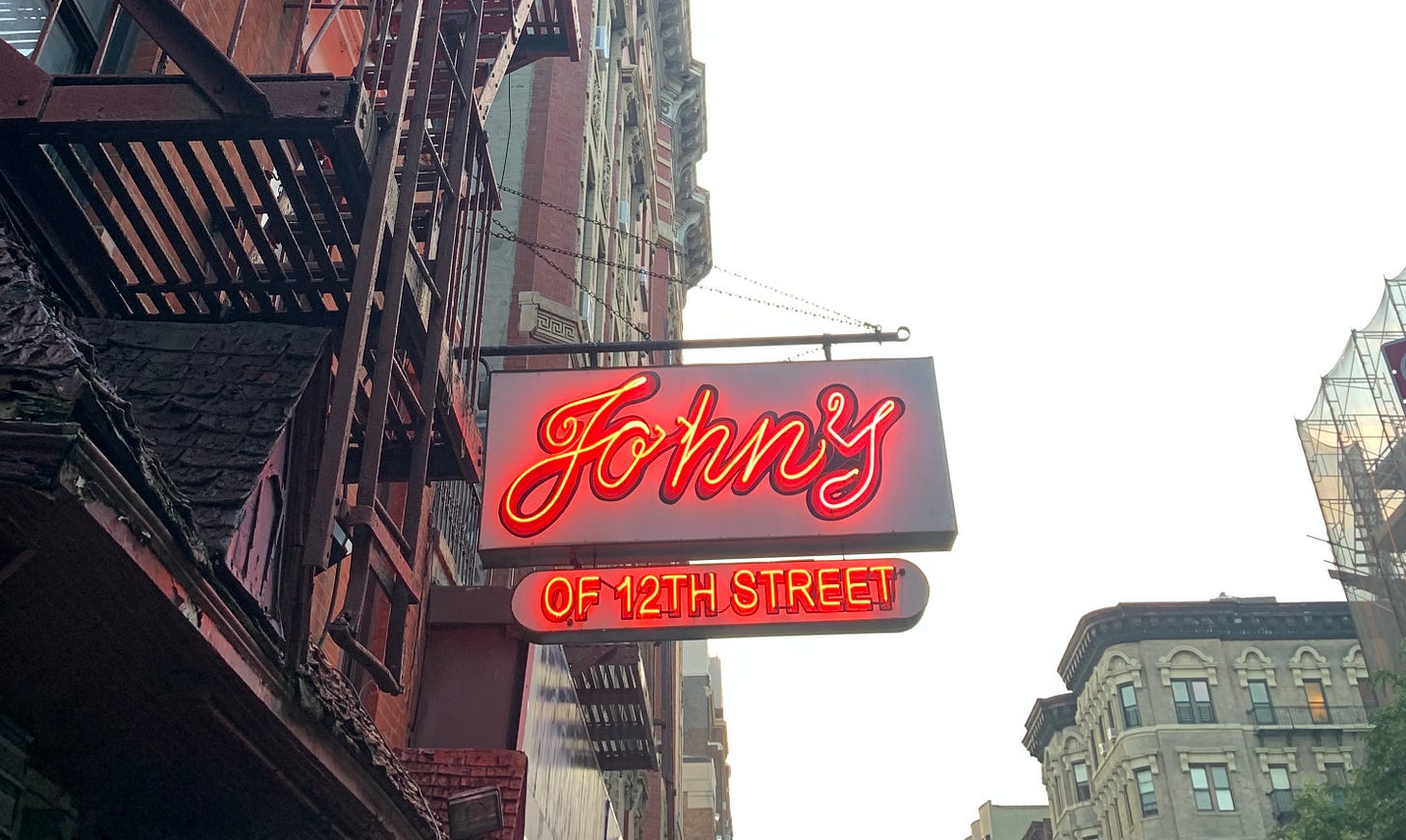every bite satiny, the texture of tongue on tongue
John's of 12th Street • East Village • Manhattan
There is a candle in the back room of a restaurant on the south side of 12th Street between 1st and 2nd Avenue. “Candle” is a funny word for what it is, maybe. It’s a many-pointed stalagmite, a wax Sagrada Família that’s been given its own altar near the entrance to the kitchen. In various articles and blog posts you’ll see that it’s been burning since Prohibition, or maybe since the repeal of Prohibition, and someone just decided to let it keep burning, and now it’s 250 pounds of dripping sooty white because they never let that flame of mourning (or celebration) go out. When I got to John’s I quickly went to inspect the candle and found it wasn’t lit at all, and I was a little disappointed, but then I thought, wait, it’s a good thing. The candle doesn’t really care that I’m here. John’s doesn’t need to put on any airs for me, quite the reverse, as I am but a blip in the history of John’s.
I bookmarked John’s when I was reading Eve Babitz a few years ago and she let slip that it was her favorite restaurant in New York, a city she wrote about briefly, very briefly, in Eve’s Hollywood, and I’m not sure I would take Eve’s advice when it comes to most lifestyle choices but eating, well, gladly and for better or worse I would follow her into the dark. John’s, well—it’s very dark in there, so I see why she liked it. (Side note: Eve’s Hollywood is one of those weird ones where people don’t seem to know what it is. Is it semi-autobiographical or semi-fictionalized, a collection of essays or the more noncommital “vignettes”? NYRB, which republished it in 2015, calls it, vaguely, “an album of vivid snapshots.” She was definitely making some of it up but nobody can say quite how much. A lot of good creative nonfiction will come with that caveat, and she was better than most. In any case, the subtitle to “New York Confidential” will set us straight on the point of John’s: No Fictional Characters—They Were Stories Enough Without It.)



Eve’s year in New York, as she tells it—she was there for one year, between 1966 and 1967, starting when she was 22, to be the “office manager” (derisive quotation marks Eve’s own) at the East Village Other—involves lots of acid at Tim Leary’s house upstate, various poets (“If anyone in L.A. said they were a poet, everyone would get mildly embarrassed and go look for someone else to talk to”), Fugs concerts, and striving to be a “slum goddess,” as per the Fugs song, which to her is mostly about going to parties and wearing eyeliner. She doesn’t like New York very much. She never really lived there at all, she says, since she knew the whole time she would give it a year and then go back to the real center of the universe, Los Angeles.
Eve spends her last months in the city in the company of the character called Mike, a shoplifting anarchist dealer with a German shepherd and a taste for fine cuisine, with whom she dines at John’s not long before skipping town forever, and her dining is an end and a beginning. As she writes in Eve’s Hollywood—“In February on Valentine’s Day Mike and I put a sticker heart on the German shepherd’s forehead and went to our favorite restaurant, John’s, on 12th Street between 1st and 2nd Avenues, I think. I realized that it was almost March, and in March I could go.”


This is where Eve’s discussion of John’s ends, so I don’t know what she ordered, but if I had to guess one thing John’s was known for in 1967, it would be what it is known for now (among other things), the ragù—beef and pork, simmer-simmering in a vat, a cauldron, the type of gravy they like to say has been on the stove all day, all year, since before my grandmother brought it here from the motherland, etc. It’s stewed until it becomes almost like soft shreds of rabbit, velveteen rabbit, then served with hand-cut fresh pappardelle a little too thick, which makes them better than if they were the correct thickness. An object lesson to teach the concept of “toothsome,” which I have heard is hard for some to grasp, being so much about the tooth’s experience and not our own.
There were also martinis, icy; and eggplant parm, molten; the soft texture of warm stuffing, something breaded and fried then slightly emulsified, dense and melty. On the side, a bundle of spaghetti with red sauce. The dish I remember most is the simplest one, the peppers and anchovies, tangled oily fish on a bloom of roasted reds—every bite satiny, the texture of tongue on tongue.
I don’t know if Eve ate any of that; all I know is that for Eve, John’s was a favorite place and also the place she realized it was almost March, and in March, she could finally go. Here our experiences of this restaurant differ, since when I was at John’s it was not almost March, far from it, probably the farthest one can be from March before you start getting closer to it, and also the realization that I had about New York while sitting in one of those crackly red-vinyl booths was one I’ve had a million times, which is, in fact, that I could stay.
“Everything about New York was a story,” per Eve, and with that I sometimes agree, especially when it comes to restaurants like John’s, where the stories are simply hanging in the air you breathe and make inevitable its eventual cameo on The Sopranos. In the 20s it was a speakeasy—you would ask to take your dessert “upstairs” and your dessert would be some of Momma John’s homemade hooch served in an espresso tazzina (just in case). During this time, Joe Masseria was a loyal customer. During this time, Joe Masseria took the man who tried to kill him to lunch as a peace offering, then had him killed right outside. Lucky, Bugsy, and Vito Genovese had their meetings here, they say. Carlo Tresca, the antifacist Wobbly agitator, ate here one night and then was promptly assassinated a few blocks away, allegedly on Vito Genovese’s orders. What I take from this is that then, as now, a lot of people could agree on John’s.
John Pucciatti opened his restaurant in 1908, which means it’s 116 years old, and I now am farther from the time Eve ate there than Eve was to the birth of John’s. No matter. I especially love old restaurants because I love the feeling of inhabiting history, not reliving it exactly but having it brought up closer into the foreground, so that I can imagine 1908, 1967, and 2024 accordioned together for a few bites. Old restaurants everywhere have the strange power to do this, I’ve found. It’s just that in New York there are so many of them, and the history, well, I think Eve put it best: “There are no spaces between the words, it’s one of the charms of the place.”



would order again: roasted peppers and anchovies, broccoli rabe, eggplant alla Parmigiana, Tuscan ragu over homemade pappardelle, martini (it is a well-made martini)





